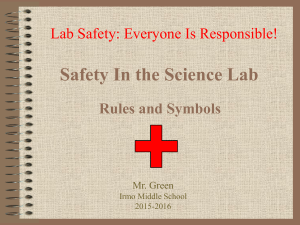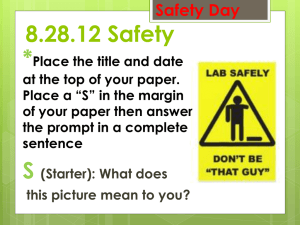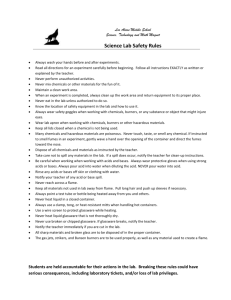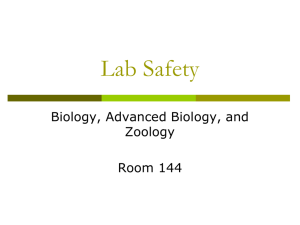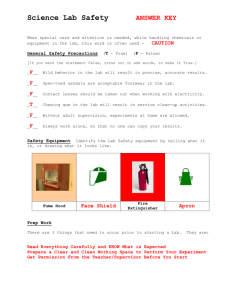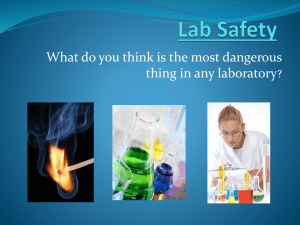Lab Safety Scenario #1
advertisement
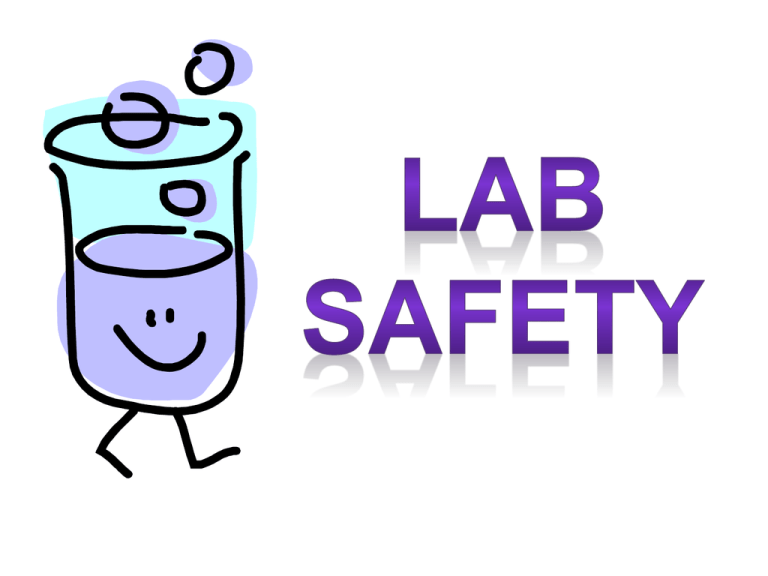
Exploring, inventing, and investigating are all essential to the study of science. However, these activities can also be dangerous. To make sure that your experiments and explorations are safe, you must be aware of a variety of safety guidelines. You have probably heard the saying, “It is better safe than sorry.” This is particularly true in a science classroom where experiments and explorations are being performed. Stop! Reflect on page L of your IAN why you think it could be important to learn about lab safety rules. Reflection can be in the form of a drawing of what could go wrong, or in a poem. Be creative, colorful, and have fun! Being uninformed and careless can result in serious injuries. Don’t take chances with your own safety or with any else’s. Always get your teachers permission before attempting any laboratory exploration. Read the procedures carefully, and pay particular attention to safety information and caution statements. If you are unsure about what a symbol means, look it up or ask. If accidents occur, inform your teacher immediately regardless of how minor you think it may be. Please leave all backpacks in the science room when working in the science lab. There is never any food or drinks allowed in the science lab. During warmer weather, water bottles can be left on the main table as you enter the lab. Clean up your table when you are done, and put back any materials you used where you found them. Stop! • Lab Safety Made Simple Safety Symbols Eye Safety Wear safety goggles when working around chemicals, acids, bases, or any type of flame or heating device, or any time there is even the slightest chance that harm could come to your eyes. If any substance gets into your eyes, notify your teacher immediately! Treat any unknown chemical as if it were a dangerous chemical. Safety Symbols Heat Wear safety goggles when using a heating device or a flame. Whenever possible, use an electric hot plate as a heat source instead of using an open flame. When heating materials in a test tube, always angle the test tube away from yourself and others. To avoid burns, wear heat-resistant gloves whenever instructed to do so. Stop! • Lab Safety Cartoon Activity Safety Symbols Electricity Be careful with electrical cords. When using a microscope with a lamp, do not place the cord where it could trip someone. Do not let cords hang over a table edge in a way that could cause equipment to fall if the cord is accidentally pulled. Do not use equipment with damaged cords. Be sure that your hands are dry and that the electrical equipment is in the “off” position before plugging it in. Turn off and unplug electrical equipment when you are finished. Safety Symbols Chemicals, clothing, and hand protection Wear safety goggles when handling any potentially dangerous chemicals or liquids. If a chemical is unknown, handle it as you would a dangerous chemical. Wear an apron and protective gloves whenever you are told to do so. If a spill gets on your skin or clothing, rinse it off immediately with water for at least 5 minutes while calling to your teacher. Never mix chemicals unless your teacher tells you to do so. Never taste, touch, or smell chemicals unless you are specifically directed to do so. If smelling a chemical, you must waft it. Stop! • Lab Safety Rap Safety Symbols Animal Safety Handle animals only as your teacher directs. Always treat animals carefully and respectfully. Wash your hands thoroughly after handling any animal. When in nature, do not touch any animal unless instructed by your teacher to do so. Safety Symbols Sharp/Pointed Objects Use knives and other sharp instruments with extreme care. Never cut objects while holding them in your hands. Place objects on a suitable work surface for cutting. Examine all glassware before use. Be sure that glassware is clean and free of chips and cracks. Report damaged glassware to your teacher. Only the teacher should clean up broken glass. Safety Symbols Plant Safety Do not eat any part of a plant or plant seed used in the laboratory. Wash your hands thoroughly after handling any part of a plant. When in nature, do not touch or pick any wild plants unless your teacher instructs you to do so. What’s Wrong With This Picture? What’s Wrong With This Picture? Stop! Complete SpongeBob Safety Challenge on Page 4 of your IAN
